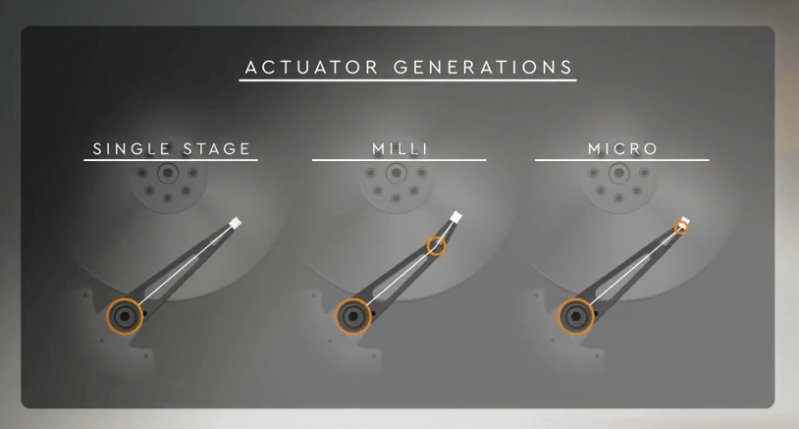One hard disk recently failed in the EEVBlog laboratory’s NAS. Keeping true to his catch phrase, [Dave “Tear it Apart” Jones] opened it up and gave us an inside tour of a modern hard disk drive. There are so many technological wonders to behold in modern HDDs these days — the mechanical design, electronics and magnetics, and the signal processing itself which is basically an advanced RF receiver — that we can forgive [Dave] for glossing over a system of piezo actuators thinking they were manufacturing test points. Even knowing they are actuators, you have to stare at them and think for a bit before your brain accepts it.
Later realizing the mistake, he made a follow-up video (down below) focusing on just the disk head actuator arms and this micro-actuation system (or perhaps they are milli-actuators). The basic concept is a pair of piezoelectric transducers mounted on either side of the short arm holding the read head. Presumably they are driven out of phase to flex the arm left or right, but the motion is imperceptible to the eye — even under magnification, [Dave] was not able to discern any motion when he pulsed the transducers. When you consider that these micro-actuators are mounted on the main actuator arm, which itself is also in motion, the nested control loop arrangement to maintain nanometers of accuracy is truly amazing. Check out this 45 second explanatory video by Western Digital which has a good animation of the concept.

If you want to see your HDD in operation without taking it apart, check out the transparent drive we wrote about last month. And to read more about esoteric actuators, check out this article from 2015 which contains one of the longest words to appear in our pages — magnetorheological. If you’ve experience a hard disk failure, which thankfully is becoming rarer these days, do you chunk it or tear it apart?

















This is a sad video.
Take a look at this guy’s channel takes them apart and repairs them
https://youtube.com/c/hddrecoveryservices
3 minute content stretched out over 16 minutes. Unfortunately this has become the eevblog standard :(
Has always been, this is actually a very short video.
He is playing around with stuff without any idea what he is doing. Just poking around, all the lame jokes again and again and nothing of value.
But I don’t complain. I just moved on.
+1
Dave in a nutshell:
– Spends half of each video talking about the video format
– Complains about “wank” like indicator lights
– Whines about software from the 90s being too newfangled for him to learn
He’s a fine specimen of the curmudgeon babyboomer engineer who’s getting left behind because he doesn’t want to adapt.
That said, the mailbag videos are always fun.
When he started, he put out some great teaching (albeit longwinded) content. Now it’s TV repair videos, dumpster diving and complaining. Would love to see him getting back to teaching. (don’t get me started about how he now considers himself an “influencer”)
It’s saddening to think that all of this is about to become a lost art, replaced by boring solid state flash memory.
Whenever a technology becomes perfected, it’s usually obsolete & replaced by something better.
That said, HDDs will still be around for a while longer. SSDs are still 3x the price per TB.
See “Temperatures and data retention” in https://www.jedec.org/sites/default/files/Alvin_Cox%20%5BCompatibility%20Mode%5D_0.pdf
SSD’s are fast, but for long term storage magnetic wins (unless the drive is filled with Helium – 5 year lifetime if powered off or on – for the hard disk manufactures it is the ultimate in planned obsolescence).
Yeah, poor data retention and proneness to catastrophic failures (maybe cause by firmware?) are two reasons for which we won’t see HDDs disappear any soon in favour of SSDs.
“Wiggle wiggle wiggle, YEAH!” Too funny.
I can’t watch the whole thing. Did he realize they are for vibration suppression? Or are they actually “actuators” to hold some particular shape?
The late great Robert Forward in the 1960’s/70’s did studies at Hughes Research on using piezo devices to damp vibrations in satellite antennas and then applied them to improving a number of instruments. This looks a lot like that application.
They have a futuristic ones in star trek but they upgraded to field dampeners.
+1
Back in the 90’s NCR put 10 meg drives (NCR 6560) made by CDC (Control Data Corporation) in grocery store scanning systems. The drives “breathed” external air through a filter that was changeable by a tech on a maintenance schedule. I had one drive crash that required me to clean the platter chamber with alcohol wipes, replace the platter and head and then reload the scanning file from cassette tape (TEAC digital). Took about 10 hours. Seeing drive teardowns reminded me of all the fun days except we had to repair it and restore it to working order.